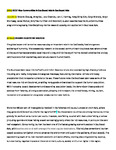Blue Communities in Southeast Asia
| dc.contributor.author | Cheung, VV | |
| dc.contributor.author | Bell, A | |
| dc.contributor.author | Creencia, L | |
| dc.contributor.author | Fleming, LE | |
| dc.contributor.author | Goh, HC | |
| dc.contributor.author | Maharja, C | |
| dc.contributor.author | Morrissey, K | |
| dc.contributor.author | Richter, Isabel | |
| dc.contributor.author | Then, AY-H | |
| dc.contributor.author | Austen, Melanie | |
| dc.date.accessioned | 2021-06-15T17:30:48Z | |
| dc.date.issued | 2021-03 | |
| dc.identifier.other | 16 | |
| dc.identifier.uri | http://hdl.handle.net/10026.1/17256 | |
| dc.description.abstract |
MARINE ECOSYSTEM SERVICES The global ocean and its marine resources play an important role in the livelihoods, food and general wellbeing of humanity. This is especially relevant to the coastal communities in Southeast Asia where almost all the countries have extensive coastlines and a long and rich history of marine-related activities that are key contributors to their economies, social structures and human health. The Southeast Asian seas link the Pacific and Indian Oceans and are characterised by high diversity habitats including coral reefs, mangroves and seagrass meadows, favoured by the tropical climate and heavy precipitation that transports nutrients to the sea. These factors make the Southeast Asian seas some of the most resource-rich on the planet, providing many goods and services that support the human population. With increasing coastal development and expanding population levels, the demands on those goods and services from fisheries, oil and gas extraction, shipping and transport, the armed forces, mining, tourism, recreation and conservation are greater pressures than ever before. | |
| dc.format.extent | 96-103 | |
| dc.language.iso | en | |
| dc.publisher | the-ies.org | |
| dc.rights | Attribution 4.0 International | |
| dc.rights | Attribution 4.0 International | |
| dc.rights | Attribution 4.0 International | |
| dc.rights | Attribution 4.0 International | |
| dc.rights | Attribution 4.0 International | |
| dc.rights.uri | http://creativecommons.org/licenses/by/4.0/ | |
| dc.rights.uri | http://creativecommons.org/licenses/by/4.0/ | |
| dc.rights.uri | http://creativecommons.org/licenses/by/4.0/ | |
| dc.rights.uri | http://creativecommons.org/licenses/by/4.0/ | |
| dc.rights.uri | http://creativecommons.org/licenses/by/4.0/ | |
| dc.title | Blue Communities in Southeast Asia | |
| dc.type | journal-article | |
| plymouth.issue | 1 | |
| plymouth.volume | 30 | |
| plymouth.publisher-url | https://www.the-ies.org/resources/creating-sustainable-future | |
| plymouth.journal | The Environmental Scientist | |
| plymouth.organisational-group | /Plymouth | |
| plymouth.organisational-group | /Plymouth/Faculty of Science and Engineering | |
| plymouth.organisational-group | /Plymouth/REF 2021 Researchers by UoA | |
| plymouth.organisational-group | /Plymouth/REF 2021 Researchers by UoA/UoA14 Geography and Environmental Studies | |
| plymouth.organisational-group | /Plymouth/REF 2021 Researchers by UoA/UoA14 Geography and Environmental Studies/UoA14 Geography and Environmental Studies MANUAL | |
| plymouth.organisational-group | /Plymouth/Users by role | |
| plymouth.organisational-group | /Plymouth/Users by role/Academics | |
| plymouth.organisational-group | /Plymouth/Users by role/Researchers in ResearchFish submission | |
| dcterms.dateAccepted | 2021-03-30 | |
| dc.rights.embargodate | 2021-6-26 | |
| dc.rights.embargoperiod | Not known | |
| rioxxterms.licenseref.uri | http://creativecommons.org/licenses/by/4.0/ | |
| rioxxterms.licenseref.startdate | 2021-03 | |
| rioxxterms.type | Journal Article/Review |



